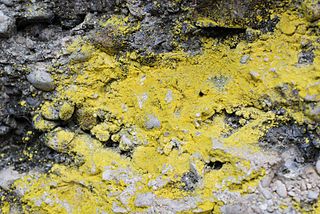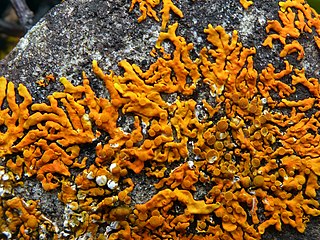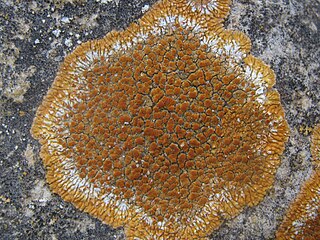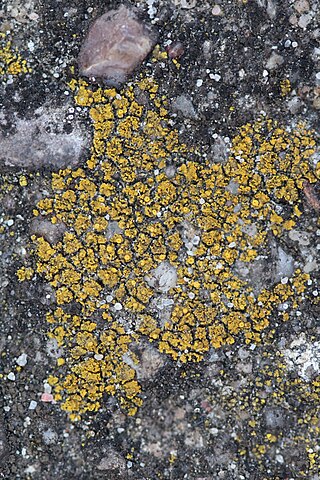
The Teloschistaceae are a large family of mostly lichen-forming fungi belonging to the class Lecanoromycetes in the division Ascomycota. The family has a cosmopolitan distribution, although members occur predominantly in subtropical and temperate regions. Although most members are lichens that either live on rock or on bark, about 40 species are lichenicolous – meaning they are non-lichenised fungi that live on other lichens. Many members of the Teloschistaceae are readily identifiable by their vibrant orange to yellow hue, a result of their frequent anthraquinone content. The presence of these anthraquinone pigments, which confer protection from ultraviolet light, enabled this group to expand from shaded forest habitats to harsher environmental conditions of sunny and arid ecosystems during the Late Cretaceous.

Gyalolechia is a genus of lichen-forming fungi belonging to the family Teloschistaceae. It contains 18 species of crustose lichens.
Austroplaca is a genus of lichen-forming fungi in the family Teloschistaceae. It has 10 species. The genus was circumscribed in 2013 by Ulrik Søchting, Patrik Frödén, and Ulf Arup, with Austroplaca ambitiosa assigned as the type species.

Calogaya is a genus of lichen-forming fungi belonging to the family Teloschistaceae. It has 19 species. The genus was circumscribed in 2013 by Ulf Arup, Ulrik Søchting, and Patrik Frödén. The generic name Calogaya honours Dr. Ester Gaya, a Spanish botanist from the University of Barcelona.

Flavoplaca is a genus of crust-like or scaly lichens in the family Teloschistaceae. It has 28 species with a mostly Northern Hemisphere distribution.

Xanthocarpia is a genus of mostly crustose lichens in the family Teloschistaceae. It has 12 species with a largely Northern Hemisphere distribution.

Leproplaca is a genus of lichen-forming fungi in the family Teloschistaceae. Its exhibits a leprose growth form, where the thallus consists primarily of asexual propagules called soredia.

Polycauliona is a genus of lichen-forming fungi in the family Teloschistaceae.

Squamulea is a genus of lichen-forming fungi in the family Teloschistaceae. It has 15 species. The genus was circumscribed in 2013 by Ulf Arup, Ulrik Søchting, and Patrik Frödén, with Squamulea subsoluta assigned as the type species. Five species were included in the original account of the genus. The genus name alludes to the squamulose growth form of most of its species. Squamulea has a worldwide distribution; when the genus was originally created, the centre of distribution was thought to be in southwestern North America.

Dufourea is a genus of mostly foliose lichen species in the subfamily Xanthorioideae of the family Teloschistaceae. Species in the genus are mostly found in the Southern Hemisphere.
Sirenophila is a genus of crustose lichens in the subfamily Teloschistoideae of the family Teloschistaceae. It has four species with an Australasian distribution.
Variospora aegaea is a species of saxicolous (rock-dwelling), crustose lichen in the family Teloschistaceae. First identified from Greek islands in the Aegean Sea, and has since been recorded in Italy and Spain.
Villophora is a genus of lichen-forming fungi in the subfamily Teloschistoideae of the family Teloschistaceae. It has 9 species. The genus was circumscribed in 2013 by Ulrik Søchting, Ulf Arup, and Patrik Frödén. They assigned Villophora isidioclada as the type, and at that time, only species in the genus. This lichen, previously classified in Caloplaca, is found in South America, Antarctica, and some subantarctic islands. Several additional species were added to the genus in 2021. The generic name Villophora means "carrying filaments".
Variospora cancarixiticola is a species of saxicolous (rock-dwelling), crustose lichen in the family Teloschistaceae. It is found in southeastern Spain, where it grows on cancarixite, a volcanic rock known only to occur in that country.

Wetmoreana is a genus of lichen-forming fungi in the family Teloschistaceae. It has two crustose, saxicolous (rock-dwelling) species.

Variospora flavescens is a species of saxicolous (rock-dwelling), crustose lichen in the family Teloschistaceae. It is a common, widely distributed species and has been recorded in Africa, Asia, Europe, and Macaronesia.
Teloschistopsis is a genus of lichen-forming fungi in the family Teloschistaceae. It has three species.
Usnochroma is a genus of lichen-forming fungi in the family Teloschistaceae. It has two species of crustose lichens. The genus was circumscribed in 2013 by lichenologists Ulrik Søchting, Ulf Arup, and Patrik Frödén, with Usnochroma carphineum assigned as the type species. The genus name refers to the yellowish-green colour of the thallus, which is caused by the substance usnic acid. Usnochroma species occur in Macaronesia, South Africa, the Mediterranean Basin, and Algeria.

Flavoplaca arcis is a species of saxicolous (rock-dwelling), crustose to squamulose (scaley) lichen in the family Teloschistaceae. Although widely distributed in Northern, Central, and Western Europe, it is not commmonly encountered.












